These days, all activities have shifted online, and shopping is no exception. Many startupers strive to build an app that allows users to shop smart by connecting directly to merchants.
This is a classic example of peer-to-peer marketplaces. Just look at Amazon and Alibaba and see how they leveraged a simple marketplace business model.
Fortunately, you no longer need to build another Amazon to succeed. You can start from the development of web platforms like Etsy.
It will also yield far better results than a typical e-commerce website. Since we know a lot about shopping apps, we decided to share some interesting insights with you.
To build a peer-to-peer marketplace platform, we need to understand the different types of p2p markets and must-have features.
What differs between a peer-to-peer marketplace app and an online store
Sometimes people think that an online store and a peer-to-peer marketplace app are the same. However, these two solutions differ significantly. So, to eliminate the confusion, we decided to begin with the proper definition of these two solutions:
An online store is a multifunctional site that makes sales possible through the Internet. It means that you, as the online store owner, conduct the sale, you bring suppliers and buyers together, you set prices and carry all expenses for the maintenance that your store requires.
A peer-to-peer marketplace app is a solution that allows two groups of people to connect: those looking for specific services or goods, and those willing to provide these products under certain conditions. Some marketplaces will allow you to monitor the execution of transactions and ensure compliance with the obligations of suppliers and customers. A person-to-person marketplace owner doesn’t make any sales; you just provide people with a platform for exchanging things. The main challenge for you is to make this platform user-friendly.
Traditional e-commerce is one of the many ways goods and services are exchanged. But peer-to-peer marketplaces similar to Etsy or Amazon are a many-to-many exchange of goods and services.
And that’s where the revolution is happening, thanks to stronger social connections and increased volumes of product you can sell through such a platform.
Even traditional brands are ramping up their peer-to-peer marketplace strategies to close the loop and sell products without intermediaries. For example, they’re creating certified second-hand marketplaces for their products to be resold, or they’re linking their experts with customers within a branded marketplace.
Online marketplaces make a profit through commission sales, affiliate programs, and promotional tools. Also, we should mention the scalability of projects and geographic coverage, which is unlimited indeed.
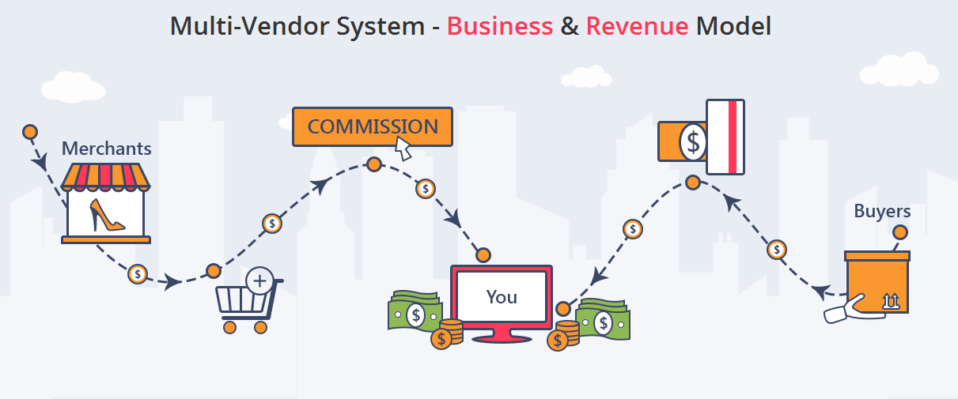
Challenges of peer-to-peer marketplace app
Peer-to-peer app development is complex. After all, you build a platform and hope that people on the supply side and demand side will come together to complete a transaction.
However, this poses some additional challenges, especially if you’re targeting FMCG (fast-moving consumer goods) that require flawless logistics.
The reason it’s so challenging is that you’ve got two sides of the market to figure out. The process is completely different from building a normal company with only one type of customer and demand. But with peer-to-peer marketplaces, you’ll have the same concept times two.
That’s why you should narrow your proposition to one single use case and only then expand categories.
Supply side – restrict the supply side to the very specific products or goods category, that you can easily control and deliver on that promise.
Demand side – focus on finding the ideal customer who needs the specific use case your particular peer-to-peer marketplace app offers.
The product category you choose will directly impact the design of your online shopping app. In particular, it will indicate how wireframes and product description pages should be structured: product-centred, description-centred, rich in pictures or else.
For example, if you choose the housing market, your app will focus on specifics such as apartment size, location, and interior facilities. On the other hand, if your app sells cars, its design should focus on mileage, vehicle class, and lease terms.
Ans, while everything is quite clear with the challenge as mentioned earlier, there are some other obstacles you may face.
One of them is inefficient searching and matching. When there are many sellers and goods on a peer-to-peer marketplace, the search function is crucial. It is recommended to think ahead about how sellers and buyers will find each other. Two types of search can be implemented:
Centralised search – helps to narrow the options for sellers and buyers, and is perfect for an on-demand business model. Centralised search is actively used by Uber and Zeek.
Decentralised search – advanced search with multiple filters, personalisation and engine-generated recommendations. The well-known peer-to-peer marketplace that uses this type of search is Etsy.
Another challenge you may face while peer-to-peer app development is the payment mechanism. We are all aware of well-known payment service providers, but in the case of P2P apps, it is crucial to choose the pricing model – auction, price adjustment in real-time or an automated pricing algorithm.
And last but not least, prioritise peer-to-peer marketplace security. It is better to take care of it in advance than deal with a data breach, money loss, and other unpleasant consequences later. You can implement:
payment protection,
transaction checks,
verification of user’s identity,
verification of devices,
licensing of service providers,
photo and description verification, etc.
Additional information
Peer-to-peer app development is tricky, so it is always better to delegate it to real professionals who are aware of all possible challenges and risks. Our experts have written a post about the most common risks here, and it is highly recommended to read it.
Popular types of marketplaces
Choosing the right marketplace approach is vital for business success. This is a very challenging subject, and unfortunately, a lot of entrepreneurs try to figure out their strategy after the app is created. However, as you can see, each of the types needs a specific set of features in order to perform well.
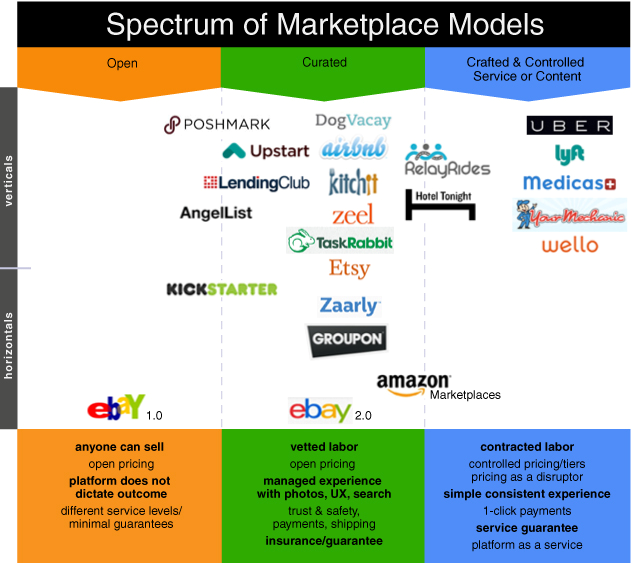
Free-for-all
eBay, Craigslist, OLX. These are basic marketplaces where everyone can place their products and sell them directly to customers. All the details, such as shipping and payments, are settled in whatever way users prefer. The quality of offerings and reliability of sellers were based on the user’s ratings.
Curated marketplaces
apps similar to Etsy and Airbnb. These are very focused platforms, with identity, privacy and trust that users demand nowadays. Such marketplaces leverage their social trust and convert this trust into liquidity of offerings.
The more trust they gain, the more attractive the sellers’ offering is. Thus, the more transactions are made through those online shopping platforms.
Fixed supply side
Uber, Fiverr, Homejoy. Such marketplaces are usually built on top of the existing curated platform. They usually have fixed offerings within a specified price range and provide consistent value.
The supply side in such online shopping sites is locked to a specific list of contractors that is strictly curated and refined by price and value.
Type of marketplace | Must-have features |
Free-for-all | – straightforward user rating |
Curated marketplaces | – strict layout for offerings |
Fixed supply side | – closed ecosystem for a specific product category |
Those are basic approaches for building liquidity in your mobile shopping app, similar to Etsy, Amazon, or ASOS. Choosing a specific approach is vital for successful business development.
How to build a peer-to-peer marketplace: Altamira tips
For more than 10 years in business, we have helped numerous startups and business owners launch their mobile shopping applications. Although we no longer develop online marketplaces from scratch, we have enough experience to provide you with some valuable advice. Also, at the moment, we help numerous clients update their existing solutions and make them more current. For example, we can easily implement advanced analytics, AI-powered features, live streaming options and many more.
So, let’s say you’ve decided to build your online shopping app. The first thing you should do is shape your idea a little bit and find a company that has all the necessary technical specialists. You will need the services of:
Business analyst;
Project manager;
Front and back-end coders;
Designers;
QA engineers.
In some cases, you may also need the DevOps and marketing teams to help you with the server-side of the app and its further promotion. The development process itself includes several main steps: writing all technical documentation, creating wireframes and design concepts, coding, quality checks, release, and further maintenance.
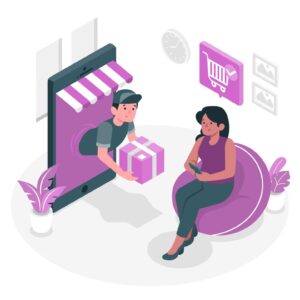
The cost of the marketplace platform development
When it comes to the budget you need to develop your online shopping app, in most cases, you’ll need to be ready to pay $50,000 or more, depending on the type of marketplace, its complexity, and feature set. However, several features and development tasks need to be added, regardless of the kind of marketplace you choose. They are the following:
UI-UX design
Back-end development
Android development
There are also must-have integrations that you definitely need to implement in your mobile shopping app if you want it to be competitive, user-friendly and highly functioning. Those integrations include but are not limited to:
Admin Panel
Chatting System
Search Engine Integration
Shipping System
To execute all those integrations and make your app visually pleasing and user-friendly, you need a bunch of technical specialists, starting with a Business analyst and a designer, and ending with high-class coders and quality assurance engineers. They all have their hourly rates, so depending on your app complexity, you will need a certain number of their working hours.
✔ Must read
In case you are still wondering how software companies estimate shopping app development, you can check out our detailed guide covering all aspects of this topic.
Identifying genuine needs for marketplace success
A successful marketplace doesn’t start with features—it starts with solving a real problem. Whether it’s helping people rent, resell, or trade, your platform needs a purpose that users can relate to.
Skipping this step often leads to building something that looks good but useless. A clear need also helps shape how you design interactions between buyers and sellers, which is central in peer-to-peer platforms.
Market research for defining products and services
Before writing any code, take the time to understand your target users. Market research helps define what your platform should offer, what categories to focus on, and what pain points to address.
It also informs the structure of your MVP—what’s essential and what can wait. The discovery phase may not be flashy, but it saves time and effort in the long run.
Choosing a monetisation model
How the platform makes money should be part of the plan from the beginning. Whether through transaction fees, subscriptions, or listing charges, the model needs to make sense for both you and your users.
It’s also crucial that your monetisation approach doesn’t interfere with trust—clear terms and visible value matter more than clever pricing tricks.
Planning for a successful marketplace launch
Launching a marketplace takes more than flipping a switch. You’ll need a basic but stable architecture, secure payment handling, simple onboarding flows, and a clear way for users to interact and review each other.
Trust is the foundation here, so both security and transparency should be built in from the start. Once the MVP is live, early testing and feedback loops are essential because real users will show you what actually works and what doesn’t.
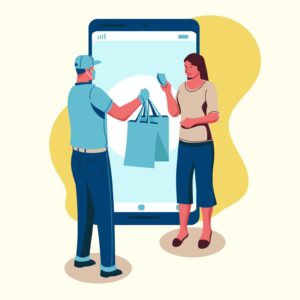
Features to boost the KPI of your e-commerce platform
As an owner of a mobile shopping app, you can earn money only from the successful transactions made through your platform, meaning the more transactions are completed, the more money you gain. By now, you’re wondering if there’s an efficient way to boost the productivity of your mobile shopping app. Well, consider these features to increase the conversion rate and earn more:
Style boards
A flexible styling system will allow merchants to design their stores in a unique, eye-catching way and make products more appealing to users.
Badges
This feature will help merchants highlight special offers and get additional sales. It may suggest items based on previous searches. For example, if users click through Gucci scarves, they will be shown closets that it thinks users will also like.
Virtual try-ons
This system is especially useful if you’re thinking about developing something similar to the ASOS shopping app. Virtual try-ons and fitting rooms will definitely reduce the number of returns and thus your profit margins.
Login via socials
This is a must-have feature. Integrating your online shopping app with social platforms will speed up the registration process, improve the user conversion rate, and offer users a more personalised experience.
Analytics
A straightforward set of sales statistics inside the app will make your app more appealing to merchants, as they won’t need any additional software to calculate expenses and marketing efforts.
Loyalty program
The app can recommend things to users they may like and offer your customers personalised rewards, so they shop at your store more often. You can even reward users for being frequent shoppers and build loyalty programs starting from a certain amount spent in your store.
Selection options
It allows users to trade items with a swap feature. Users can list an item and make it available for selling and/or swapping.
Smart navigation
Your online shopping app should provide an easy search for the desired product for the user, and don’t forget about smart filters.
User-friendly design
The intuitive, clean design is half of the success, and your online peer-to-peer marketplace platform is no exception. Therefore, it is important to hire a competent UI/UX expert to create an interface for your mobile resource.
Engaging elements
The majority of popular trading platforms employ a typical and uninspiring approach to business, which reduces user engagement. Therefore, any conceptual innovations can attract the target audience and help to stand out from the competition. You can diversify the process of selecting and buying goods with a game component and thereby increase user involvement.
Live streaming – a game-changing technology for mobile shopping apps
The world of technology changes fast and shapes many businesses. These days, live streaming has become one of the leading technologies that can change even the shopping industry.
Real-time streams showcase the goods, allowing people to click on proposals and be redirected to the website where they are sold. What can be more convenient and faster than that? Can you imagine how fast you can seal the deal using live streaming sessions?
Can you realise how many new clients you can attract? Live streaming technology is powerful, and it grants mobile shopping apps that use it a huge competitive advantage.
Here at Altamira, we have recently implemented live streaming into one successful online shopping platform. The main idea for our client was to stream online, demonstrate the products an online shop offers, and let people quickly navigate to products and add them to their cart.
Live streaming was supposed to be a tool that could attract new clients, increase their engagement, and encourage them to purchase more items. The client’s plan was genius and worked like a charm. After we finished our job and released the solution, the client’s sales increased, and their client base expanded.
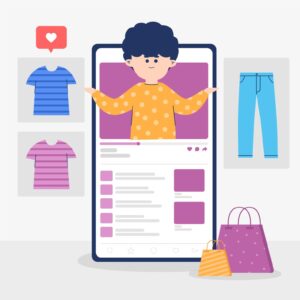
FAQ
All you need is a great app idea, a certain budget for its development, and a team of developers to help you turn your idea into a real project. We also recommend that you complete the Discovery stage to find your unique selling point and select the right mobile shopping app type, along with the best feature set for it.
The price range is $50,000 to $120,000 and higher. Everything depends on the app type, the desired feature set, and the complexity of the solution. The price tag is high, indeed, but you can always opt for MVP development, which is more affordable. Moreover, it lets you test your idea and get real feedback.
In general, you will need to wait 3-6 months until your app is all set and ready. There are some cases when the development takes longer.
Because if the marketplace doesn’t solve a problem people have, it’s going to struggle, no matter how polished it looks. Starting with a genuine need helps keep the platform focused, useful, and worth returning to. It also gives you a clearer sense of who your users are and what matters to them.
Market research isn’t just about numbers—it’s about figuring out what your users are already doing, what they’re frustrated by, and what’s missing from existing options. That information helps you define the core features of your marketplace and avoid building things no one asked for. It also points to gaps you can fill that others haven’t.
Planning isn’t just about setting dates. It’s about choosing the right scope for your first launch, setting up the infrastructure to support it, and knowing how you’ll measure whether it’s actually working. That includes everything from technical setup to user onboarding to a plan for gathering feedback once you’re live.


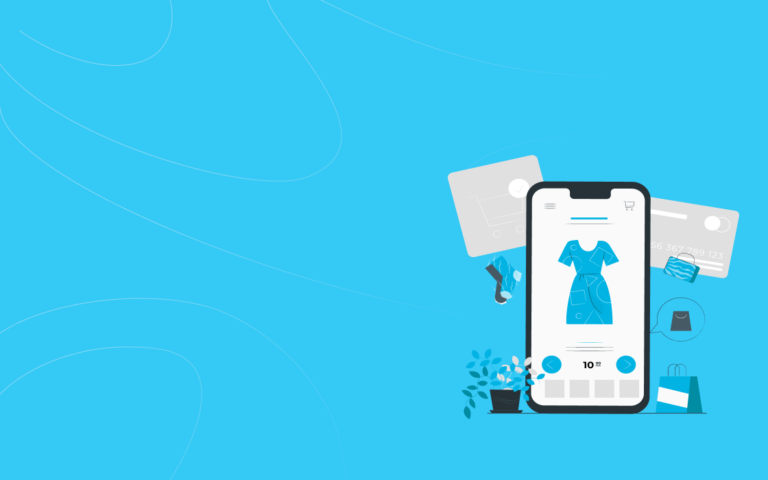




2 Responses
Informative guide on creating a peer-to-peer mobile shopping app. Valuable insights for developers and entrepreneurs in mobile commerce.
Great read on building a peer-to-peer mobile shopping app! It provides practical steps and tips for creating a seamless and user-friendly platform.